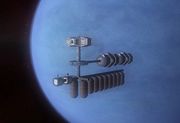Article possibly outdated (v4.86
)This article has not been verified to be up to date for the latest version of the Discovery mod. The last edit was made on 17.12.2012 (
DD/MM/YYYY). You may help by
updating it, often by using the
code generator.
Cambridge system is located at the frontier of the Bretonia system, and serves as the primary food producing system for various planets and bases throughout Bretonia and aboard. Other than food, Cryer Pharmaceuticals have also established a base in this system, concentrating on the production of pharmaceuticals. On the other side, this system heavily consumes diamonds, optical chips and alien organisms. In fact, a very short and lucrative run of commodity involves transporting diamonds from Rheinland to this system or Leeds.
System Overview
|
Astronomical Bodies
Stellar Objects
- Planet Cambridge
- Ross Planetoid
- Planet Sarum
- Grasmere Ice Cloud
- Keswick Ice Cloud
- Cardiff Asteroid Field
- Newcastle Asteroid Field
|
Industrial Development
- Beryllium Ore (multiple)
- Water (multiple)
|
Faction Presence
Lawful Factions
Corporations & Guilds
Unlawful Factions
|
Jump Gates and Holes
Planetary Bodies
- A serene, beautiful planet covered in lush, green plains and deep blue oceans, planet Cambridge is eminently suited to human colonisation. Settled during the colony's formative years, the planet is largely given over to farming and scientific concerns, with heavy industry of any kind strictly prohibited. It is also home to the Cambridge Research Institute, a science academy that is devoted to pure scientific research. Many important scientific breakthroughs have occurred on Cambridge through the Institute, without which the Bretonian food shortages would also be considerably more severe. Thanks to advances in crop engineering, Cambridge is also now the primary food producer for the entire of Bretonia.
- Location: D/6
- Diameter: 10,723 km.
- Mass: 5.11 x 10e25 kg.
- Terrain: Terrestrial
- Temperature: -49°C to 73°C
- Escape Velocity: 10.21 km/sec
|
|
Ross Planetoid
- Smaller than some asteroids, the Ross Planetoid exists at a gravitational sink where ice fragments have collected over the millennia and begun to compact under their own weight into the seed of what might eventually become a planet. Ross presents a unique opportunity for the Cambridge Research Institute to study planetary formation and extend their terraforming technology.
- Location: F/5
- Diameter: 200 km
- Mass: 0.66 x 10e20 kg
- Terrain: N/A
- Temperature: N/A
- Escape Velocity: N/A
|
|
Planet Sarum
- A large gas giant composed mostly of ice crystals. Deep sonar surveys have shown the presence of rare gases in vast frozen fields; however, they are located kilometers beneath the planet's surface making them impossible to collect. The Cardiff Mining Facility orbits the planet, collecting beryllium from nearby asteroid fields.
- Location: E/3
- Diameter: 28,312 km
- Mass: 9.92 x 10e24 kg
- Terrain: N/A
- Temperature: N/A
- Escape Velocity: 15.46 km/sec
|
|
Nebula and Asteroids
Grasmere Ice Cloud
- A thick cloud of small ice asteroids. The refractive nature of the cloud tends to confuse most scanners, providing excellent cover for Corsairs who launch raids across the Cambridge Line.
- Location: F/6
|
|
Keswick Ice Cloud
- A thick cloud of small ice asteroids. The refractive nature of the cloud tends to confuse most scanners, providing excellent cover for Corsairs who often launch attacks on the Trade Lane to the Omega-3 Jump Gate.
- Location: G/4
|
|
Cardiff Asteroid Field
- A medium-sized asteroid field notable for its large deposits of Beryllium. A branch of the Independent Mining Guild (IMG) based on the Cardiff Mining Facility has been working the field with lucrative results, despite occasional raids by Corsairs who have managed to circumvent the Cambridge Line.
- Location: E/3
|
|
Newcastle Asteroid Field
- A large rock asteroid field, used as cover by particularly bold Corsairs to attack traffic to and from the New London Gate. It contains no minerals of economic value.
- Location: D/3
|
|
Space Stations
-
- Location: D/6
- Class: Eden
- Gravity: Partial
- Docking: Yes
- Amenities: Yes
- Population: 350
|
 Cambridge Research Station |
-
- Location: F/5
- Class: Dunkirk
- Crew: CLASSIFIED
- Armament: CLASSIFIED
|
|
-
- Location: E/3
- Class: Wellington
- Gravity: Partial
- Docking: Yes
- Amenities: Limited
- Population: 500
|
|
- Discovered in 794 A.S. by Molly scouts returning from a reconnaissance mission into Omega 5, Lisburn Rock was the perfect location to construct a fortress for basing Molly forces at, from which they would be able to combat Corsair incursions into Bretonia. A huge rock asteroid located on the edges of the Keswick ice cloud in Cambridge, the interior was hollowed out and construction was eventually completed in 804 A.S.
- Location: G/3
- Class: Lough
- Gravity: Complete
- Docking: Yes
- Amenities: Yes
- Population: 140
|
|
Mineable Commodities
- Ore is a type of rock that contains minerals such as metals which can be extracted through mining and refined for use. The ores must be processed to extract the metals of interest from the waste rock and from the ore minerals. Many organizations prefer to receive unsmelted ores in order to keep the additional cost of their production and finish within the local economy, as opposed to paying markups to foreign laborers to do the work for them.
- Location: B/5, E/3
|
Error creating thumbnail: Unable to save thumbnail to destination |
- Dihydrogen monoxide (H2O) is odorless, tasteless, transparent, and absolutely essential to human life. Roughly 75% of the human body is composed of Water. Deprived of Water, most humans can only live three days. The process of dehydration is a painful one, as tissues shrivel and vessels shrink in a desperate bid by the dying body to preserve its remaining vital functions.
- Location: G/4, F/6
|
Error creating thumbnail: Unable to save thumbnail to destination |







